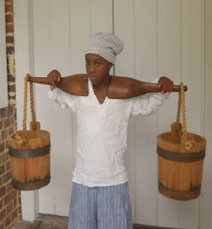Jacob and the Other Domestic Servants

How might the water have been used?
In the tavern, Jacob encountered many people. He lived with indentured servants, convict servants, and other slaves. William Gray, for instance, served in the Brown house in 1762. As an indentured servant, Gray had to work for a particular period of time, after which he would once again become a free man. Mary, a convict servant, worked there too. She had been sentenced to serve a term of years in the colonies, instead of being executed for the crime she had committed in England. (England then punished more than 250 crimes, including minor thefts, with the death penalty, which was often commuted to “transportation.”) Like William, she would be freed after serving a particular term, usually seven to fifteen years.
Then there was Sall, a young enslaved woman. According to land records, she was purchased in 1760. She was known as a “country-born” slave, as she had been born in the Chesapeake region. House servants were often young girls or older women. Sall and Jacob, like other enslaved people, had little chance of ever becoming free. In all likelihood, Jacob lived in the basement of the Brown House with Mary and Sall. As you read, you will learn more about a typical day for Jacob.


